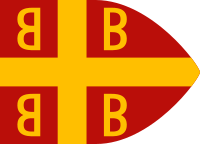Ameralios
| Byzantine Navy | |
|---|---|
| Participant in the Justinianic Wars, the Arab–Byzantine wars, the Byzantine–Bulgarian wars, the , the Byzantine–Norman wars, the Crusades and the Byzantine–Ottoman wars | |

The imperial ensign (basilikon phlamoulon) with the tetragrammic cross, carried by Byzantine warships in the 14th century, as described by Pseudo-Kodinos and illustrated in the Castilian atlas Conosçimiento de todos los reynos (c. 1350)
|
|
| Active | 330–1453 |
| Leaders |
Byzantine Emperor (Commander-in-chief); droungarios tou ploïmou and thematic stratēgoi (8th–11th centuries), megas doux (after c. 1092) |
| Headquarters | Constantinople |
| Area of operations | Mediterranean Sea, Danube, Black Sea |
| Size | c. 42,000 men in 899. c. 300 warships in 9th–10th centuries. |
| Part of | Byzantine Empire |
| Originated as | Roman navy |
| Allies | Venice, Genoa, Pisa, Crusader states, Aydinids |
| Opponents | Vandals, Ostrogoths, Umayyad and Abbasid Caliphates, Emirate of Crete, Fatimids, Slavs, Bulgarians, Rus', Normans, Genoa, Venice, Pisa, Crusader states, Seljuks, Anatolian beyliks, Ottomans |
 |
|
| This article is part of the series on the military of the Byzantine Empire, 330–1453 AD | |
| Structural history | |
|---|---|
| Byzantine army: East Roman army, Middle Byzantine army (themes • tagmata • Hetaireia), Komnenian-era army (pronoia), Palaiologan-era army (allagia) • Varangian Guard • Generals (Magister militum • Domestic of the Schools • Grand Domestic • Stratopedarches • Protostrator) | |
| Byzantine navy: Greek fire • Dromon • Admirals (Droungarios of the Fleet • Megas doux) | |
| Campaign history | |
| Lists of wars, revolts and civil wars, and battles | |
| Strategy and tactics | |
| Tactics • Siege warfare • Military manuals • Fortifications (Walls of Constantinople) | |
The Byzantine navy was the naval force of the East Roman or Byzantine Empire. Like the empire it served, it was a direct continuation from its Imperial Roman predecessor, but played a far greater role in the defence and survival of the state than its earlier iteration. While the fleets of the unified Roman Empire faced few great naval threats, operating as a policing force vastly inferior in power and prestige to the legions, the sea became vital to the very existence of the Byzantine state, which several historians have called a "maritime empire".
The first threat to Roman hegemony in the Mediterranean was posed by the Vandals in the 5th century, but their threat was ended by the wars of Justinian I in the 6th century. The re-establishment of a permanently maintained fleet and the introduction of the dromon galley in the same period also marks the point when the Byzantine navy began departing from its late Roman roots and developing its own characteristic identity. This process would be furthered with the onset of the Muslim conquests in the 7th century. Following the loss of the Levant and later Africa, the Mediterranean Sea was transformed from a "Roman lake" into a battleground between Byzantines and Arabs. In this struggle, the Byzantine fleets were critical, not only for the defence of the Empire's far-flung possessions around the Mediterranean basin, but also for repelling seaborne attacks against the imperial capital of Constantinople itself. Through the use of the newly invented "Greek fire", the Byzantine navy's best-known and feared secret weapon, Constantinople was saved from several sieges and numerous naval engagements were won for the Byzantines.
Initially, the defence of the Byzantine coasts and the approaches to Constantinople was borne by the great fleet of the Karabisianoi. Progressively however it was split up into several regional (thematic) fleets, while a central Imperial Fleet was maintained at Constantinople, guarding the city and forming the core of naval expeditions. By the late 8th century, the Byzantine navy, a well-organized and maintained force, was again the dominant maritime power in the Mediterranean. The antagonism with the Muslim navies continued with alternating success, but in the 10th century, the Byzantines were able to recover a position of supremacy in the Eastern Mediterranean.
...
Wikipedia
